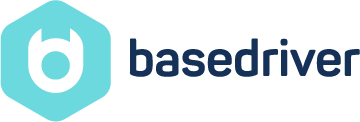How to grow a scale-up with content and data
- As a (B2B) scale-up you have a limited marketing budget combined with the ambition to grow fast.
- The first customers of a scale-up often come from the network, after that it is necessary to build a customer base outside the network.
- With a combination of content and data, it is possible to grow faster at lower costs. At Basedriver, this has led to 10X more online traffic and 10X more weekly subscriptions to the newsletter.
This post is based on our own experience with our marketing and sales efforts over the past eight months. We have a B2B/SAAS platform called Basedriver. After a period of rapid growth within a niche, we set ourselves a goal at the end of last year: accelerate that growth outside of our niche.
Sales challenge of a B2B/SAAS Scale-up
As a scale-up, you have already experienced an initial period of rapid growth. It is very likely that this growth started from the founder’s network. First customers are a former employer, former colleagues or customers; the founders know their problems thoroughly.
If the experiences of the first customers are good, this leads to new customers within the same network. Users change employer, potential customers talk to each other or you have a success case in the same industry. These first experiences will lead to new customers and you go beyond the stage of a startup.
With Basedriver, we also experienced this. One of our first customers was publisher New Skool Media. Based on the successes with this publisher, we eventually managed to bind 7 more publishers who together represent more than 100 magazines. Publishers now represent about half of our total customer base.
The main source of customers was our network of users and acquaintances. People who know each other, talk about us and have the same partners. We have acquired a good position within the magazine ecosystem.
However, this first phase was followed by a difficult challenge. To accelerate growth, we had to look beyond our current network. Getting in touch with interested people who we don’t know yet and who don’t know us yet.
For this reason, at the end of last year we included in our annual plan the objective of growing outside our existing network. This is is the only way to move from niche player to the established order.
The pitfall of cold leads
Initially, we tried to start ‘traditional’ lead generation and sales. A subscription to LinkedIn Sales Navigator, creating lead lists based on the profile of our existing customers and approaching leads via LinkedIn Inmails.
The idea is that if you approach 100 people, 10 wants to drink a cup of coffee and there might be one of them who wants to become a customer.
There are companies that take care of this and have tools to automate this. In the period November to March we tried several options, but not with the desired result.
The biggest problem: nobody likes to get a message that is not relevant. You annoy 90 people to reach 10. That ratio cannot be the basis for successful growth.
That is why we decided in February to do things completely different. No cold LinkedIn messages, no white papers distributed via partners but a modern marketing approach based on content and data.
Creation of targeted content
A precondition for growth is reach. In our case, we focused on reach via LinkedIn and our own website. However, we had too little online visit, 60 followers on our LinkedIn page and we knew almost everyone personally in our newsletter database. A quick way is Google Ads, but that is expensive and had too little response. After all, as a scale-up, we have a limited marketing budget.
So, the choice was quickly made to get started with content marketing and distribute that content via the website, LinkedIn and e-mail.
Now we are lucky that I enjoy writing, which I’ve been doing for Twinkle Magazine for years and have previously published a lot on Marketingfacts. We complemented this competence with a student who supports the creation, translation and planning of content two days a week.
Since February, we have been disciplined to publish an article on the website every week. These articles all have a specific subject which is close to our proposition. Topics are e-mail marketing software, marketing costs, digital marketing or e-mail newsletters.
Our content is not specifically about Basedriver, but mainly about interesting topics for our target group For each article, we establish the relationship between the article and the possibilities of Basedriver. Our content is timeless and we update the most important articles on a monthly basis.
We also try to supplement the articles with interesting images and video. Where possible, we add a training video, such as in our article on retention marketing, where you can immediately see how you can create a retention campaign in Basedriver.
We have made all of our content freely available. So without registration or any other threshold. In addition, we share our content in sponsored posts on LinkedIn. That is now the only expenditure we do for advertisements.
The results are now clearly visible. Weekly traffic from search engines has grown 10X compared to January 2020. The number of followers on LinkedIn has increased from 60 in December to almost 600 in July.

A messaging framework for high-tech scale-ups
As soon as we got traffic, we moved on to the next step. People visited our website because of the interesting content, not because of our product. As a scale-up, we were a newcomer in the world of e-mail marketing and marketing automation. This is a world where established parties and well-known agencies have been in charge for decades.
It is crucial that interested visitors build up interest in our software and see how we distinguish ourselves from the existing possibilities. Otherwise, we are mainly generating traffic, but not adding value.
Initially we tried this by comparing ourselves to e-mail marketing software. The danger of this is that we are soon seen as a kind of Mailchimp. A comparison that is flawed both in terms of price and product.
As soon as we conduct a demonstration, everyone understands the difference. We didn’t get that clear on the website. That is why we developed a new messaging framework together with the team. We found the basis for our messaging framework on Medium.

Messaging framework
The messaging framework forms the basis for our new communication. Based on the format, we started looking for external sources of information. We asked all customers why they chose us. We also used studies from McKinsey, DDMA, Forrester and Gartner.
We became a scale-up by developing a good product, only now we have started working on our message to the outside world.
In the images below you see the homepage of Basedriver and the landing page, which is based on the new messaging framework. This is still being tested, the first results look good.
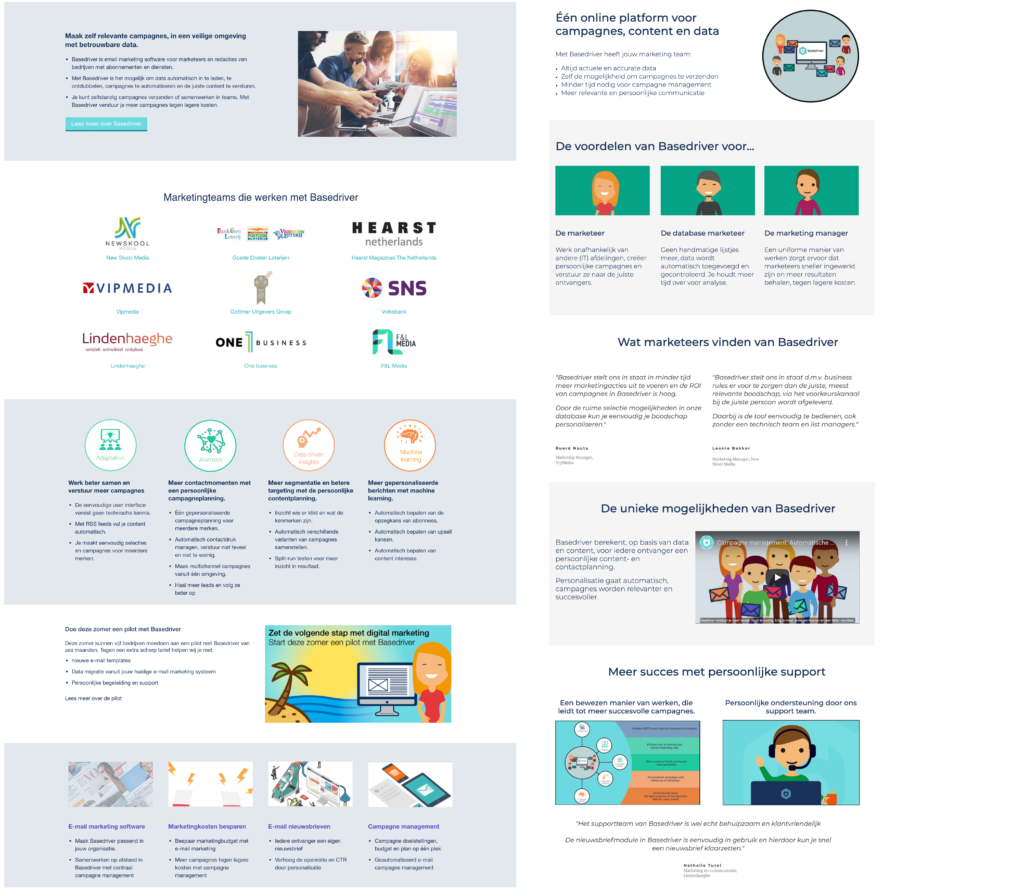
Old (left) and new (right) landing page based on the messaging framework
As you can see, in the new framework we focus very clearly on the greatest added value of Basedriver for marketing teams. We make clear for whom it is intended and we support this with evidence from our existing customers.
We also have extra content that people receive when they subscribe to our newsletter, which gradually makes them familiar with our product. The new messaging framework for high-tech scale-ups enables us to make clear to visitors what our platform stands for and increases the chance of conversion.
Data as the connecting factor between content and conversion
With the help of content on the website and LinkedIn, we are able to significantly increase our reach. Product communication based on the messaging framework gives interested parties a good idea of the distinctive character of our platform. But in order to get that message across, you need to retain visitors to you.
The e-mail address is the connecting factor between content and conversion. We use lead or registration forms for all communications, both on the website and LinkedIn. Especially at LinkedIn, this has resulted in an enormous increase in the conversion from unknown visitor to well-known newsletter recipient.
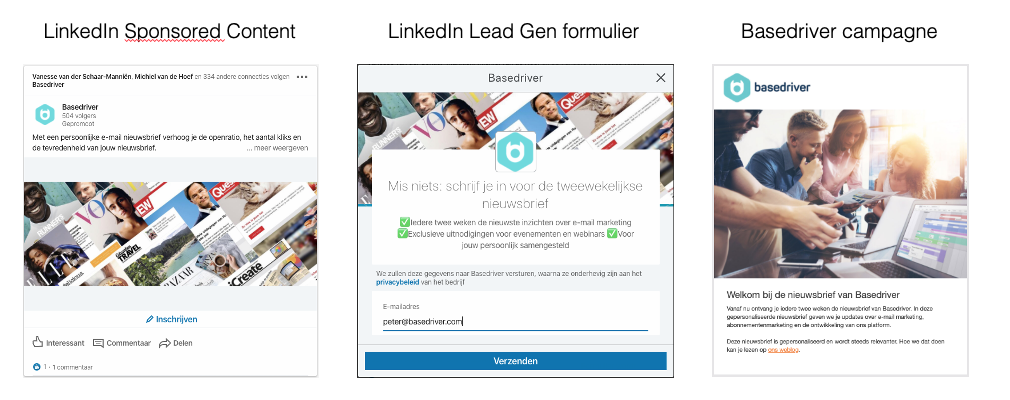
We use LinkedIn to grow the mailing list.
Lead forms are automatically linked to our marketing database. Everyone who has registered will immediately receive an e-mail with interesting content. After that, they receive the personal Basedriver newsletter every two weeks.
We have also linked the other sources of data in this way, just like the database with users of our software. This gives us one accurate and qualitative marketing database.
This approach has led to a significant increase in the number of newsletter subscriptions. At the beginning of this year, there were less than ten subscribers per month. At the time of writing this, the number of newsletter subscriptions has increased tenfold. These people are of course not all directly interested in our product, but they are interested in our content.
Distribution of content with personal newsletters
The newsletter should ensure that we remain top-of-mind and that our target group learns more about our product. We send the most relevant content and measure the response based on characteristics, click behavior and articles that people have previously received. The newsletter is now sent in more than 30 different versions, fully automatic.
We have set it up in such a way that you get the most relevant (timeless) content from our database. If you haven’t opened an email, we will offer that content again later. In this way, we make optimal use of the existing content and everyone receives a relevant newsletter.
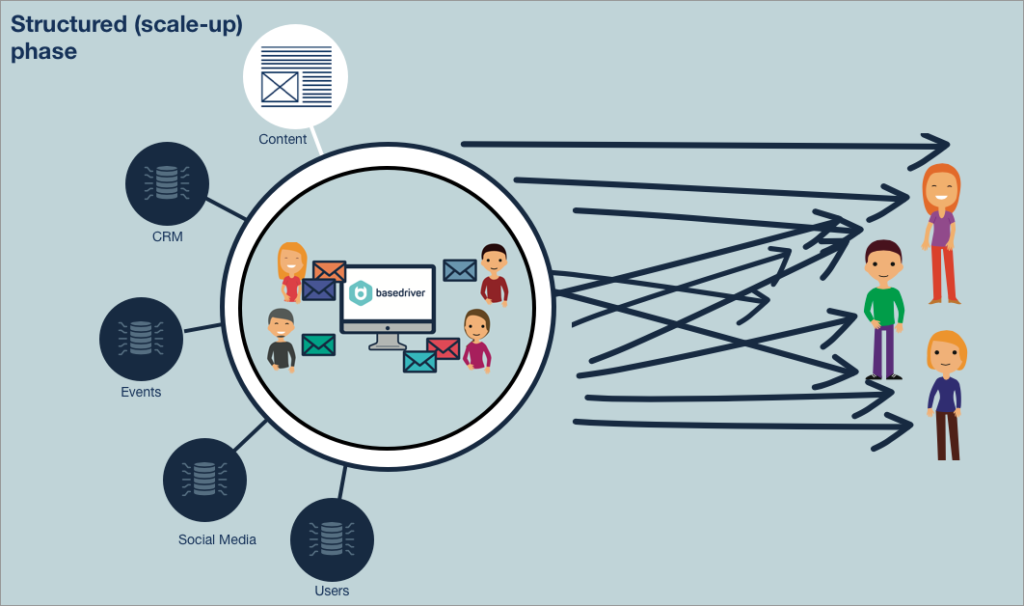
Different colleagues can create and distribute content.
Concrete call-to actions to interested customers
10X more traffic and 10X more newsletter subscriptions is very good, but the objective is sales outside our existing network. That became even more relevant in March, when our sales pipeline came to a complete standstill after the lockdown. Fortunately, we had already been working on our new approach for two months, so we decided to put even more effort into this.
Now that the newsletter file is starting to grow, we have started to build in call-to-actions. We learned from existing and potential customers that making all those links is an intensive process for both sides. We have therefore created a new proposition in which customers can try out our product for six months. Links with social media are standard, because those are valuable for our customers!
We spread this proposition in our newsletter to the expected interested people, as one of the articles in the newsletter.
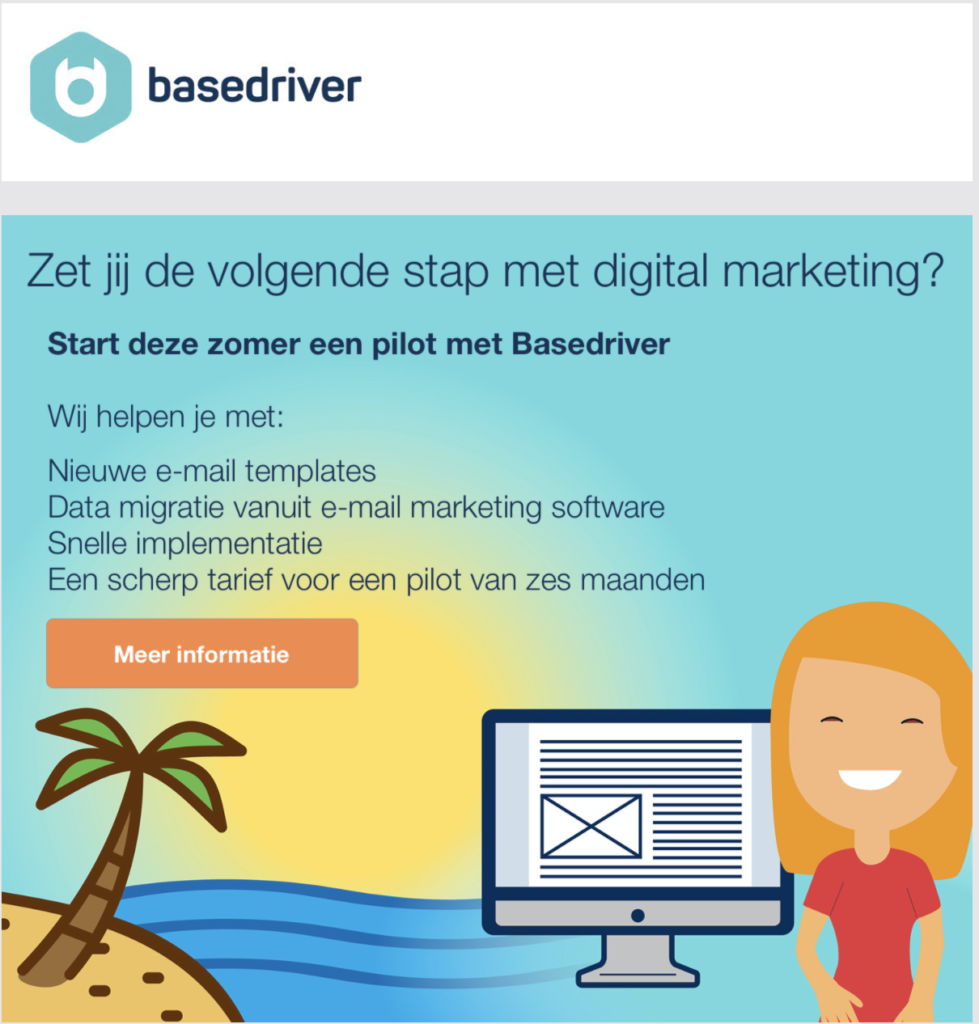
an e-mail with call to action
Only when people have clicked, but haven’t filled in a form, sales come into action. We approach these people separately to see if they have any questions and if the offer is clear. We also try to schedule a demonstration at this moment.
The results after six months with a new approach
In March of this year, at the start of the lockdown, we saw our acquisition pipeline come to a standstill. Almost every new prospect postponed investments. This is difficult for a scale-up that has budgeted for growth. Fortunately, the use of our existing customers has increased enormously, but that does not completely make up for the lack of new customers.
At the time of writing this, however, we are seeing the applications for the pilot in August gradually fill up. It seems that we will be able to partly catch up with our new customer target. With this, we have taken a strategically very important step for our company. We have succeeded in acquiring customers who do not come directly from our own network.
Marketing costs consist partly of advertising costs on LinkedIn and partly of the various tools we use. On our website we provide an overview of the marketing tools we have chosen. Our total marketing costs are about 2% of our annual revenue, excluding personnel.
Of course, this approach takes a lot of time, which only becomes visible over time. We have chosen to do a lot ourselves, it can be done faster if you hire an agency for creating content or a messaging framework. This balance between time and money is often seen in scale-ups.
However, the most important thing is to make the connection between content and data. Content leads to visitors, registrations and data. You use that data to offer people more relevant content, which makes people more and more interested in your solution.
Digital Marketing with Basedriver
Basedriver connects content, data and campaigns in one online platform for marketing teams. With Basedriver, marketing teams can automatically plan campaigns, view histories and create personalized versions. This is all based on reliable and up-to-date marketing data from various source systems.
With Basedriver we connect with more than 2000 different websites and apps. If you are going to create landing pages from your CMS or within an external tool, you can automatically load the data from the form into Basedriver so you can use it in campaigns.
This post is also available in:
 Nederlands (Dutch)
Nederlands (Dutch)
